A 3C-SiC-on-Insulator-Based Integrated Photonic Platform Using an Anodic Bonding Process with Glass Substrates
Abstract
:1. Introduction
2. Platform Development
3. Experimental Results
4. Conclusions
Author Contributions
Funding
Acknowledgments
Conflicts of Interest
References
- Bogdanov, S.; Shalaginov, M.Y.; Boltasseva, A.; Shalaev, V.M. Material Platforms for Integrated Quantum Photonics. Opt. Mater. Express 2017, 7, 111. [Google Scholar] [CrossRef]
- Chabert, P.; Cunge, G.; Booth, J.P.; Perrin, J. Reactive Ion Etching of Silicon Carbide in SF6 Gas: Detection of CF, CF2, and SiF2 Etch Products. Appl. Phys. Lett. 2001, 79, 916–918. [Google Scholar] [CrossRef]
- Ding, Y.; Zhu, X.; Xiao, S.; Hu, H.; Frandsen, L.H.; Mortensen, N.A.; Yvind, K. Effective Electro-Optical Modulation with High Extinction Ratio by a Graphene-Silicon Microring Resonator. Nano Lett. 2015, 15, 4393–4400. [Google Scholar] [CrossRef] [PubMed]
- Wang, C.; Fang, Z.; Yi, A.; Yang, B.; Wang, Z.; Zhou, L.; Shen, C.; Zhu, Y.; Zhou, Y.; Bao, R.; et al. High-Q Microresonators on 4H-Silicon-Carbide-on-Insulator Platform for Nonlinear Photonics. Light Sci. Appl. 2021, 10, 139. [Google Scholar] [CrossRef]
- Guidry, M.A.; Yang, K.Y.; Lukin, D.M.; Markosyan, A.; Yang, J.; Fejer, M.M.; Vučković, J. Optical Parametric Oscillation in Silicon Carbide Nanophotonics. Optica 2020, 7, 1139. [Google Scholar] [CrossRef]
- Lukin, D.M.; Dory, C.; Guidry, M.A.; Yang, K.Y.; Mishra, S.D.; Trivedi, R.; Radulaski, M.; Sun, S.; Vercruysse, D.; Ahn, G.H.; et al. 4H-Silicon-Carbide-on-Insulator for Integrated Quantum and Nonlinear Photonics. Nat. Photonics 2020, 14, 330–334. [Google Scholar] [CrossRef]
- Ou, Y.; Uang, K.A.I.H.; Amel, A.Y.N.K.; Enriksen, M.A.R.H.; Ørgensen, A.S.A.J.; In, X.O.U.; Aiyan, H.O.U. High-Quality Factor, High-Confinement Microring Resonators in 4H-Silicon Carbide-on-Insulator. Opt. Express 2019, 27, 13053–13060. [Google Scholar]
- Liang, D.; Roelkens, G.; Baets, R.; Bowers, J.E. Hybrid Integrated Platforms for Silicon Photonics. Materials 2010, 3, 1782–1802. [Google Scholar] [CrossRef]
- McHargue, C.J.; Williams, J.M. Ion Implantation Effects in Silicon Carbide. Nucl. Inst. Methods Phys. Res. B 1993, 80, 889–894. [Google Scholar] [CrossRef]
- Wang, L.; Dimitrijev, S.; Han, J.; Iacopi, A.; Hold, L.; Tanner, P.; Harrison, H.B. Growth of 3C-SiC on 150-mm Si(100) Substrates by Alternating Supply Epitaxy at 1000 °C. Thin Solid Film 2011, 519, 6443–6446. [Google Scholar] [CrossRef]
- Geng, X.; Wang, F.; Tian, H.; Feng, Q.; Zhang, H.; Liang, R.; Shen, Y.; Ju, Z.; Gou, G.Y.; Deng, N.; et al. Ultrafast Photodetector by Integrating Perovskite Directly on Silicon Wafer. ACS Nano 2020, 14, 2860–2868. [Google Scholar] [CrossRef] [PubMed]
- Li, Z.; Liu, X.; Zuo, C.; Yang, W.; Fang, X. Supersaturation-Controlled Growth of Monolithically Integrated Lead-Free Halide Perovskite Single-Crystalline Thin Film for High-Sensitivity Photodetectors. Adv. Mater. 2021, 33, 1–10. [Google Scholar] [CrossRef]
- Hong, E.; Li, Z.; Yan, T.; Fang, X. Surface-Tension-Dominant Crystallization of 2D Perovskite Single Crystals for Vertically Oriented Hetero-/Homo-Structure Photodetectors. Nano Lett. 2022, 22, 8662–8669. [Google Scholar] [CrossRef]
- Fan, T.; Moradinejad, H.; Wu, X.; Eftekhar, A.A.; Adibi, A. High-Q Integrated Photonic Microresonators on 3C-SiC-on-Insulator (SiCOI) Platform. Opt. Express 2018, 26, 25814. [Google Scholar] [CrossRef] [PubMed]
- Fan, T.; Wu, X.; Eftekhar, A.A.; Bosi, M.; Moradinejad, H.; Woods, E.V.; Adibi, A. High-Quality Integrated Microdisk Resonators in the Visible-to-near-Infrared Wavelength Range on a 3C-Silicon Carbide-on-Insulator Platform. Opt. Lett. 2020, 45, 153. [Google Scholar] [CrossRef]
- Powell, K.; Li, L.; Shams-Ansari, A.; Wang, J.; Meng, D.; Sinclair, N.; Deng, J.; Lončar, M.; Yi, X. Integrated Silicon Carbide Electro-Optic Modulator. Nat. Commun. 2022, 13, 1–7. [Google Scholar] [CrossRef]
- Lu, X.; Lee, J.Y.; Feng, P.X.L.; Lin, Q. High Q Silicon Carbide Microdisk Resonator. Appl. Phys. Lett. 2014, 104, 8–11. [Google Scholar] [CrossRef]
- Lu, X.; Lee, J.Y.; Lin, Q. High-Frequency and High-Quality Silicon Carbide Optomechanical Microresonators. Sci. Rep. 2015, 5, 1–9. [Google Scholar] [CrossRef]
- Powell, K.; Shams-Ansari, A.; Desai, S.; Austin, M.; Deng, J.; Sinclair, N.; Lončar, M.; Yi, X. High-Q Suspended Optical Resonators in 3C Silicon Carbide Obtained by Thermal Annealing. Opt. Express 2020, 28, 4938. [Google Scholar] [CrossRef]
- Xing, P.; Ma, D.; Ooi, K.J.A.; Choi, J.W.; Agarwal, A.M.; Tan, D. CMOS-Compatible PECVD Silicon Carbide Platform for Linear and Nonlinear Optics. ACS Photonics 2019, 6, 1162–1167. [Google Scholar] [CrossRef]
- Knowles, K.M.; van Helvoort, A.T.J. Anodic Bonding. Int. Mater. Rev. 2006, 51, 273–311. [Google Scholar] [CrossRef]
- Phan, H.P.; Cheng, H.H.; Dinh, T.; Wood, B.; Nguyen, T.K.; Mu, F.; Kamble, H.; Vadivelu, R.; Walker, G.; Hold, L.; et al. Single-Crystalline 3C-SiC Anodically Bonded onto Glass: An Excellent Platform for High-Temperature Electronics and Bioapplications. ACS Appl. Mater. Interfaces 2017, 9, 27365–27371. [Google Scholar] [CrossRef] [PubMed]
- Tatar, E.; Torunbalci, M.M.; Alper, S.E.; Akin, T. A Method and Electrical Model for the Anodic Bonding of SOI and Glass Wafers. In Proceedings of the 2012 IEEE 25th International Conference on Micro Electro Mechanical Systems (MEMS), Paris, France, 29 January–2 February 2012; pp. 68–71. [Google Scholar] [CrossRef]
- Xu, Y.; Shen, M.; Lu, J.; Surya, J.B.; Sayem, A.A.; Tang, H.X. Mitigating Photorefractive Effect in Thin-Film Lithium Niobate Microring Resonators. Opt. Express 2021, 29, 5497. [Google Scholar] [CrossRef] [PubMed]
- Van Helvoort, A.T.J.; Knowles, K.M.; Holmestad, R.; Fernie, J.A. Anodic Oxidation during Electrostatic Bonding. Philos. Mag. 2004, 84, 505–519. [Google Scholar] [CrossRef]
- Ladouceur, F.; Love, J.D.; Senden, T.J. Effect of Side Wall Roughness in Buried Channel Waveguides. IEEE Proc. Optoelectron. 1994, 141, 242–248. [Google Scholar] [CrossRef]
- Qiu, H.; Zhang, X.; Zhou, F.; Qie, J.; Yao, Y.; Hu, X.; Zhang, Y.; Xiao, X.; Yu, Y.; Dong, J. A Continuously Tunable Sub-Gigahertz Microwave Photonic Bandpass Filter Based on an Ultra-High-Q Silicon Microring Resonator. J. Light. Technol. 2018, 36, 4312–4318. [Google Scholar] [CrossRef]
- Ji, X.; Barbosa, F.A.S.; Roberts, S.P.; Dutt, A.; Cardenas, J.; Okawachi, Y.; Bryant, A.; Gaeta, A.L.; Lipson, M. Ultra-Low-Loss on-Chip Resonators with Sub-Milliwatt Parametric Oscillation Threshold. Optica 2017, 4, 619. [Google Scholar] [CrossRef]
- Zhang, M.; Wang, C.; Cheng, R.; Shams-Ansari, A.; Lončar, M. Monolithic Ultra-High-Q Lithium Niobate Microring Resonator. Optica 2017, 4, 1536. [Google Scholar] [CrossRef]
- Steiner, T.J.; Castro, J.E.; Chang, L.; Dang, Q.; Xie, W.; Norman, J.; Bowers, J.E.; Moody, G. Ultrabright Entangled-Photon-Pair Generation from an AlGaAs-On-Insulator Microring Resonator. PRX Quantum. 2021, 2, 010337. [Google Scholar] [CrossRef]
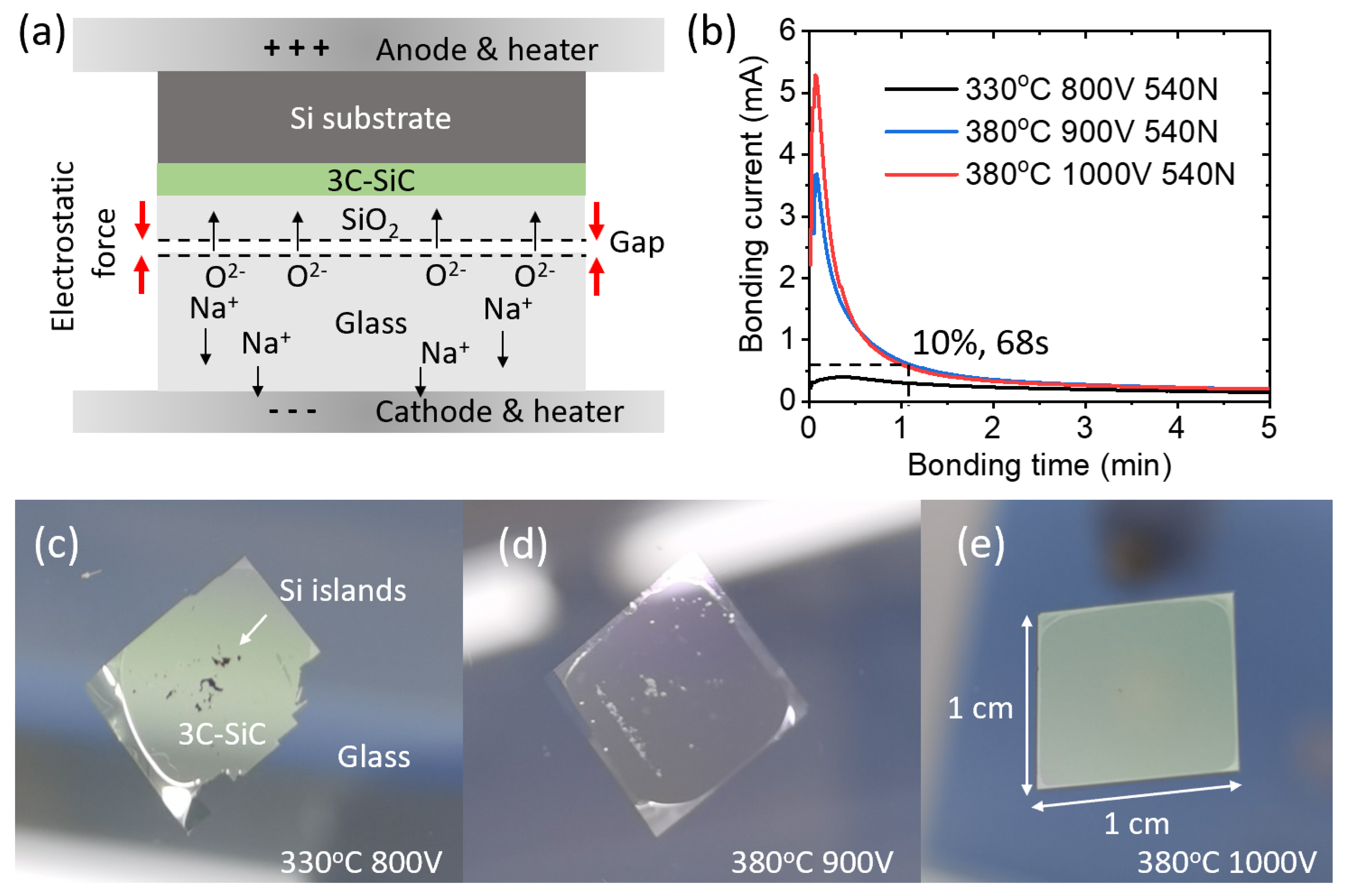
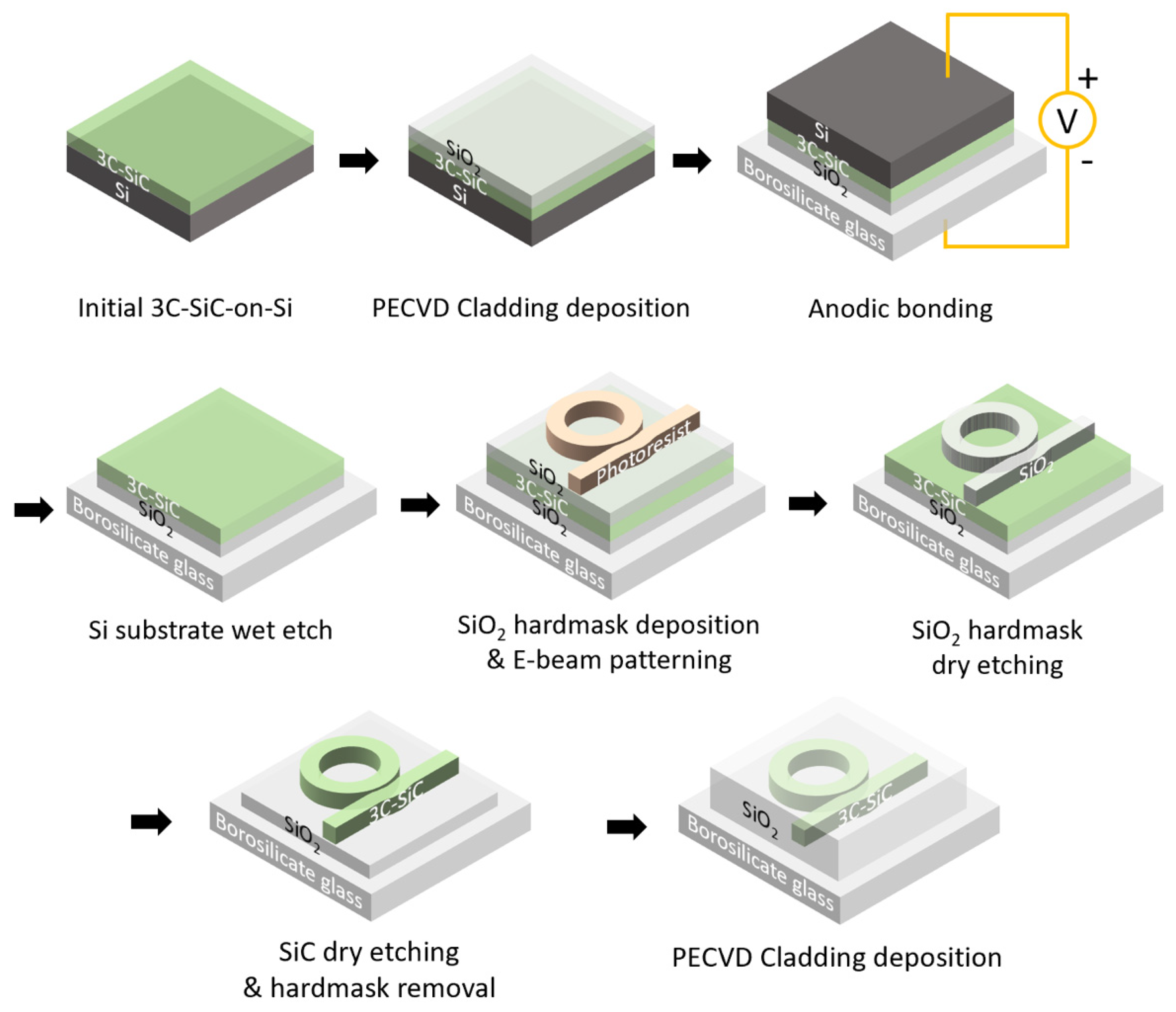
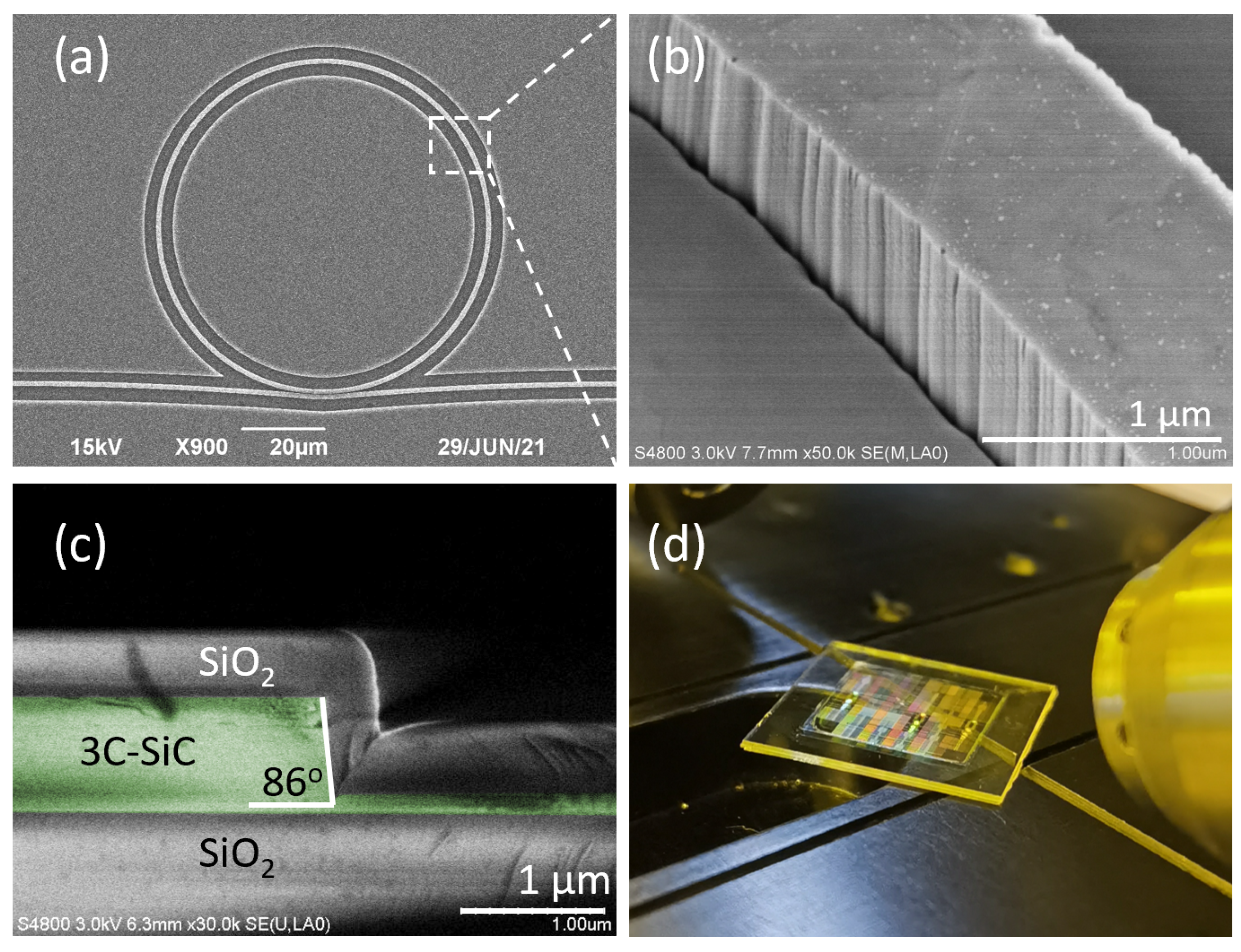

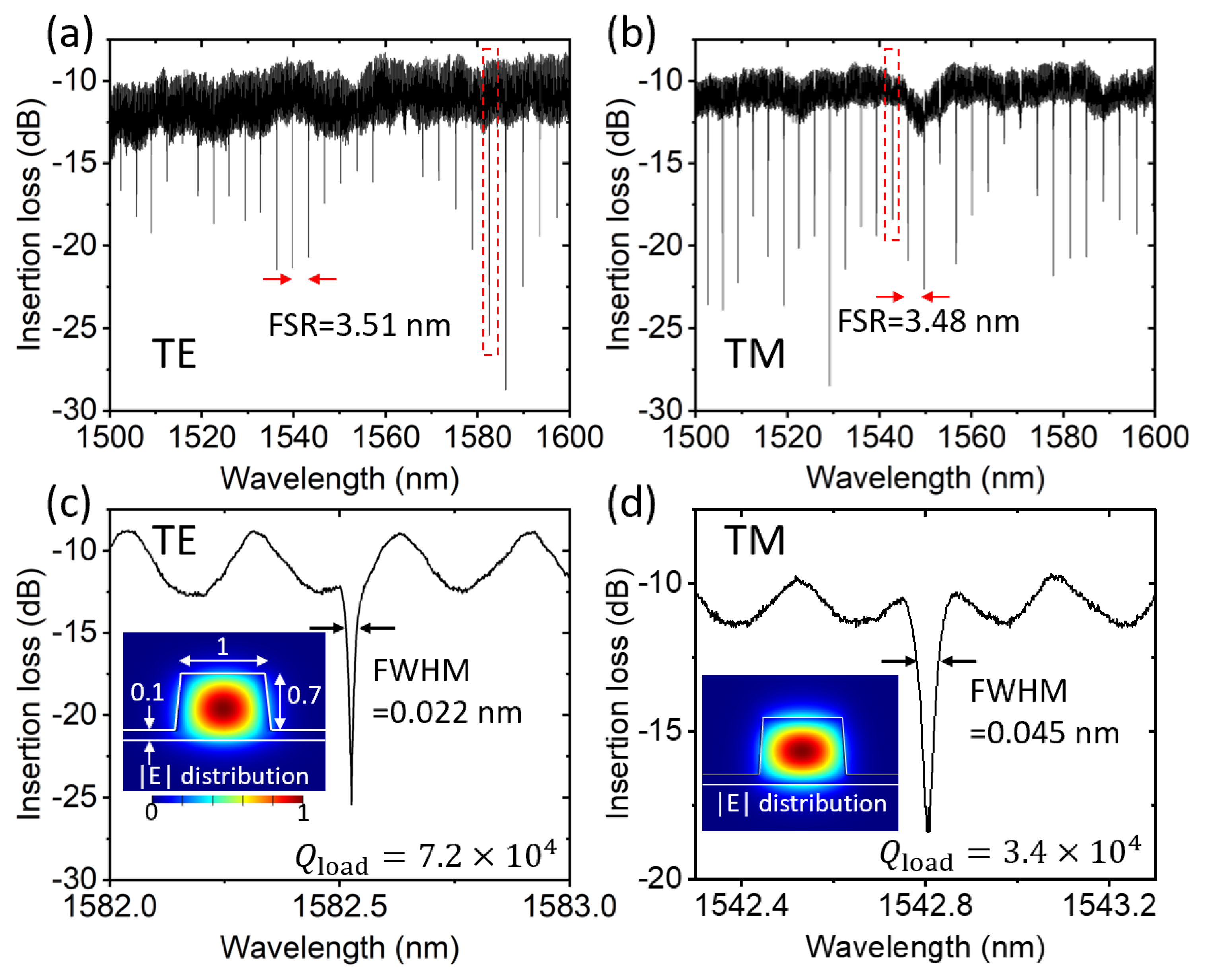
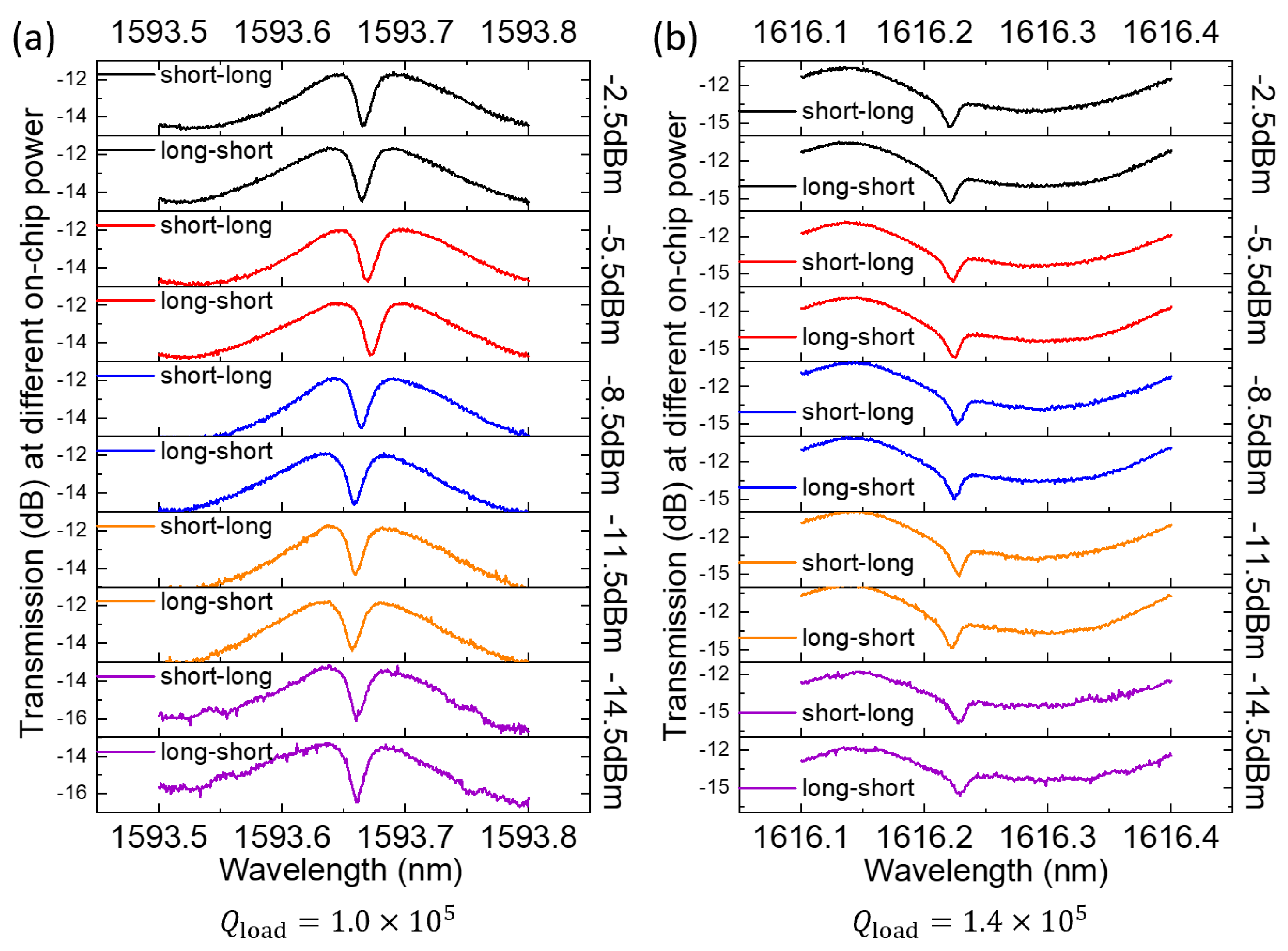
| Platform | Key Fabrication Steps | Device Parameters (Thickness, Width 1, Radius) | Reported Loaded Q’s |
|---|---|---|---|
| Silicon-on-insulator [27] | Smart-cut and Molecular bonding | 220 nm, 2 μm, 20 μm | 1.14 × 106 |
| Silicon nitride [28] | Deposition | 730 nm, 10 μm, 369 μm | 6.7 × 107 3 |
| LiNbO3 [29] | Smart-cut and Molecular bonding | 600 nm, 2.4 μm, 80 μm | 5 × 106 |
| AlGaAs-on-insulator [30] | Molecular bonding | 400 nm, 0.69 μm, 13.91 μm | 1.24 × 106 |
| Amorphous SiC [20] | Deposition | 350 nm, 0.8 μm, 50 μm | 1.4 × 105 |
| 4H-SiCoI [4] | Molecular bonding and Wafer polishing | 530 nm, 3 μm, 100 μm 2 | 9.7 × 105 |
| 4H-SiCoI [6] | Smart-cut and Molecular bonding | 500 nm, 0.75 μm, 16.5 μm 2 | 7.4 × 104 |
| 3C-SiCoI [14,15] | Molecular bonding | 800 nm, 1.7 μm, 40 μm 500 nm, −60 μm (disk) | 1.42 × 105 3 2.42 × 105 3 |
| 3C-SiC suspended [19] | Si undercut | 450 nm, 0.58 μm, 40 μm | 4.1 × 104 3 |
| This work, 3C-SiCoI | Anodic bonding | 800 nm, 1 μm, 40 μm | 1.4 × 105 |
Disclaimer/Publisher’s Note: The statements, opinions and data contained in all publications are solely those of the individual author(s) and contributor(s) and not of MDPI and/or the editor(s). MDPI and/or the editor(s) disclaim responsibility for any injury to people or property resulting from any ideas, methods, instructions or products referred to in the content. |
© 2023 by the authors. Licensee MDPI, Basel, Switzerland. This article is an open access article distributed under the terms and conditions of the Creative Commons Attribution (CC BY) license (https://creativecommons.org/licenses/by/4.0/).
Share and Cite
Li, J.; Poon, A.W. A 3C-SiC-on-Insulator-Based Integrated Photonic Platform Using an Anodic Bonding Process with Glass Substrates. Micromachines 2023, 14, 399. https://doi.org/10.3390/mi14020399
Li J, Poon AW. A 3C-SiC-on-Insulator-Based Integrated Photonic Platform Using an Anodic Bonding Process with Glass Substrates. Micromachines. 2023; 14(2):399. https://doi.org/10.3390/mi14020399
Chicago/Turabian StyleLi, Jiayang, and Andrew W. Poon. 2023. "A 3C-SiC-on-Insulator-Based Integrated Photonic Platform Using an Anodic Bonding Process with Glass Substrates" Micromachines 14, no. 2: 399. https://doi.org/10.3390/mi14020399
APA StyleLi, J., & Poon, A. W. (2023). A 3C-SiC-on-Insulator-Based Integrated Photonic Platform Using an Anodic Bonding Process with Glass Substrates. Micromachines, 14(2), 399. https://doi.org/10.3390/mi14020399






